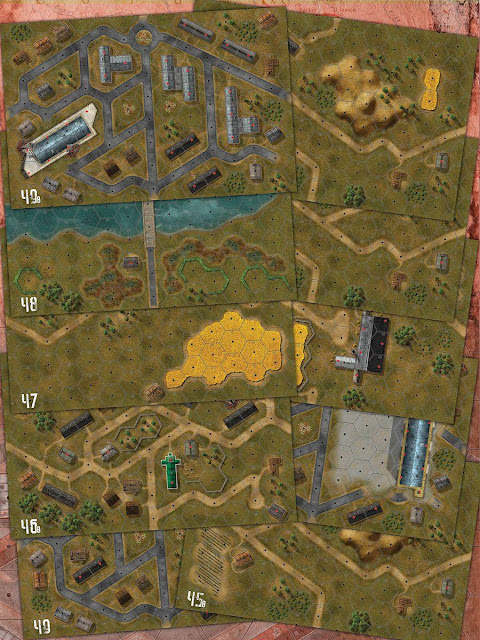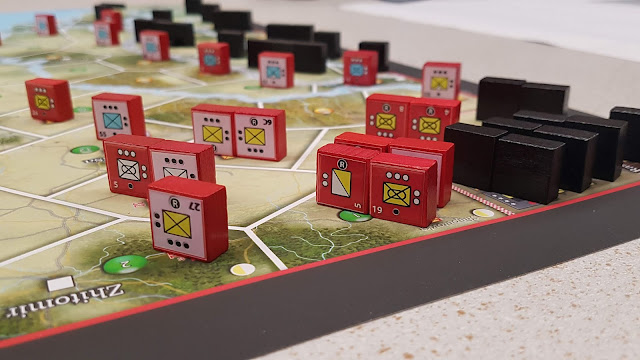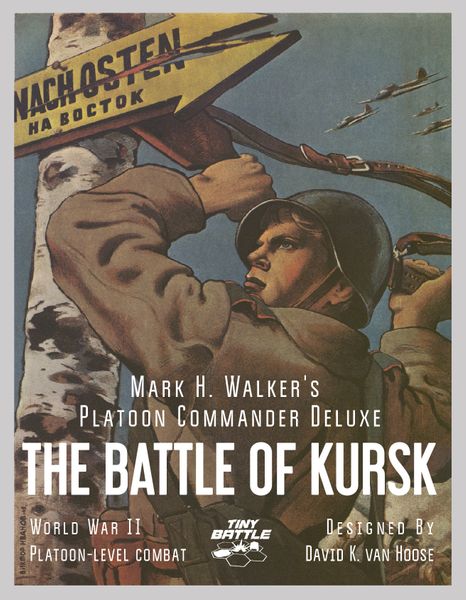From The Realm of a Dying Sun Volume 1 by Douglas E. Nash Sr. This is an amazing book from cover to ...

For your Wargamer, Toy soldier collector, MiniFig collector, military history nut. Reviews, interviews, Model Making, AARs and books!
Eastern Front
From The Realm of a Dying Sun Volume 1 by Douglas E. Nash Sr.
First Look at the Upcoming 'Fire and Rubble' the First Module for Combat Mission Red Thunder Th...

For your Wargamer, Toy soldier collector, MiniFig collector, military history nut. Reviews, interviews, Model Making, AARs and books!
Eastern Front
First Look at the Upcoming 'Fire and Rubble' the First Module for Combat Mission Red Thunder
Kiev '41 by VentoNuovo Games The Germans have come a cropper against the Soviet Union in the southern part...

For your Wargamer, Toy soldier collector, MiniFig collector, military history nut. Reviews, interviews, Model Making, AARs and books!
Eastern Front
Kiev '41 by VentoNuovo games
1. Les Preludes - July 1941
2. The River - August to the end of September 1941
3. The Pocket - September to the end of October 1941
4. The Snow - November to the end of December 1941
5. The Southern Struggle Campaign Game - July to the end of
December 1941
2. 1 Rules manual
3. 2 rules Summary and Player's Aids
4. 151 PVC Stickers
5. 2 Orders of Battle/Scenario Setup Aids
6. 56 Wooden Markers: 1 Weather Forecast Marker (yellow
cylinder); 1 Initiative Disc (large green disc); 2 Weather
Markers (white discs); 4 Soviet Supply and Control Discs
(1 yellow, 1 orange, 1 light blue, 1 blue); 13 Artillery Fire
Markers(squares, 2 blue, 4 black, and 7 red); 20 Area
Control Markers (cubes, 10 red, 10 black); 5 River
Crossing Markers (blue cubes); 10 Out of Supply Markers
(white cubes);
7. 112 wooden Block Counter Units (black, blue, brown, green,
tan, and red blocks)
8. 8 Luftwaffe Bombers (8 black discs)
9. 2 Soviet Fleets (red plates)
10. 4 Dice
Map: 1:1,000,000 (1cm = 10Km)
Players: 2 Players, with excellent solitaire suitability
Sequence of Play
1. Logistics Phase (2,3,4,5, and 6 turn)
2. Impulse Phase (player with the initiative first)
Bad weather Check (2nd impulse of October)
Supply Check (always)
HQ Activation Segment (TI only)
Command Segment (always)
Combat Segment (TI and SI only)
Blitz Segment (TI only)
HQ Deactivation Segment (TI only)
Isolation Check (always)
Exploitation (playing the Initiative Disc after a TI)
3. Final Phase
I will use their own words to describe a turn:
"A Turn is made up of a variable number of Impulses, from a minimum of two, up to unlimited. When a new Turn starts, the player with the Initiative plays the 1st impulse, followed by the other player, and so on.
A player may:
a. play a Strategic Impulse (SI) or
b. play a Tactical Impulse (TI) or
c. Pass
After two consecutive Passes (by the two players. one per player), the Turn ends and a new one begins."
And the verdict is (drum roll please), another winner from VentoNuovo Games. This game, while using the mechanics of its older siblings, is in most ways a lot tougher nut to crack, at least in the beginning. The player will get to see exactly what Amy Group South was up against during Barbarossa. The components are second to none (especially if you avail yourself of the more expensive options). The gameplay is as usual a winner (when you have a winning combination, why change it). The addition of all of the randomness in the games, as mentioned, lead to each game being different. It also lends itself to solitaire play. This is a great selling point in this day and age. Thank you VentoNuovo for allowing me to review this game. Owners of the first two in the Barbarossa trilogy will be pleased to know that work is being done to make all three playable together. What a monster that will be!
My reviews of the other two games in the trilogy:
https://www.awargamersneedfulthings.co.uk/2018/07/moscow-41-by-vento-nuovo-games.html
https://www.awargamersneedfulthings.co.uk/2019/08/leningrad-41-by-ventonuovo-games.html
1914 Glory's End/When Eagles Fight by GMT Games This game box actually contains two separa...

For your Wargamer, Toy soldier collector, MiniFig collector, military history nut. Reviews, interviews, Model Making, AARs and books!
Eastern Front
1914 Glory's End/When Eagles Fight by GMT Games
This game box actually contains two separate games. Ted Raicer originally designed both for (sob) Command magazine. I don't have many of the Command magazines, but the few I have I keep pristine and they are some of my prized possessions. Mr. Raicer was like a prophet in the wilderness when he started designing WWI games. No one was interested in WWI; it was all static trench warfare without any room to maneuver or use any finesse. Oh, how wrong we were. World War I is actually one of my favorite eras to wargame, especially the Eastern Front. There you have sweeping and swirling campaigns. The first game, '1914 Glory's End', is about the first campaign on the Western Front of WWI. So it is about the German army's swing through Belgium to outflank the French and take Paris. This culminates with the 'Race to the Sea' and the 'Kindermord Bei Ypern' (The Massacre of the Innocents at Ypres). While history has taught us that the German reservists were actually closer to middle age, they were still massacred in droves. The second game, 'When Eagles Fight', represents the entire war on the Eastern Front. The chaotic nature of the first and second years of the war come through loud and clear.
Two countersheets
Two Player Aid Cards
One Pad of Roster Sheets
One Rules Booklet
One Mini-map
Two Countersheets
Two Player Aid Cards
One Rules Booklet
Two dice
This is the Turn Sequence for 1914 Glory's End:
B. Entrenching Phase (Turns 10-30 Only)
C. Command Control Phase (Not on Turn 1)
D. Strategic Movement Phase (Not on Turn 1)
E. Operational Movement & March Combat Phase
F. Prepared Combat Phase
G. Attrition Phase (7.12)
H. Allied Victory Check Phase (Not on Turn 30*) * On Game Turn 30 make one mutual victory check at the end of the turn, adding in all conditional VPs at that time.
II. German Player Turn
A. Reinforcement, Replacement & Withdrawal Phase (Not on Turn 1)
B. Entrenching Phase (Turns 10-30 Only)
C. Command Control Phase (Not On Turn 1)
D. Strategic Movement Phase
E. Operational Movement & March Combat Phase
F. Prepared Combat Phase
G. Attrition Phase (7.12)
H. German Victory Check Phase (Mutual Check on Turn 30*)
This is the Turn Sequence for When Eagles Fight:
I. Random Events Phase (From Game Turns 5 to 24)
II. New Units & Withdrawals Phase A. Russian • Reinforcements • Replacements • Withdrawals B. Central Powers • Reinforcements • Conversions • Replacements • Withdrawals III. Strategic Movement Phase
A. Russian
B. Central Powers
IV. The Russian Player Turn
A. Russian Regular Movement Phase
B. Russian Combat Phase
C. Russian Attrition Phase
V. The Central Powers Player Turn
A. Central Powers Regular Movement Phase
B. Central Powers Combat Phase
C. German OberOst Combat Phase
D. Central Powers Attrition Phase
VI. Victory Check (Game Turns 2, 6, 11, 15, 20, 24)
https://www.gmtgames.com/p-401-1914-glorys-end-when-eagles-fight.aspx
Robert
Mark H. Walkers Platoon Commander Deluxe The Battle of Kursk Tracks in the Mud The Battle of Kursk Strategy Guide by Fl...

For your Wargamer, Toy soldier collector, MiniFig collector, military history nut. Reviews, interviews, Model Making, AARs and books!
Eastern Front
Mark H. Walker's Platoon Commander Deluxe the Battle of Kursk With the Kickstarter Extras by Flying Pigs Games
This is a link to game and expansion:
https://flyingpiggames.com/t/platoon-commander-deluxe
So, What's Different?
I hear that a lot. With all the tactical games on the market, what makes Platoon Commander Deluxe: Kursk different?
Clutterless counters. PCD:K uses color to determine a weapon's range. For example, an Armor Piercing factor printed on gold indicates that the weapon can fire normally at a target up to four hexes away.
Unique phasing. Players alternate attacking in the Fire Phase, but move all their units at once during the Movement Phase.
Flanking Friendly Close Assault Phase. Units do not enter the hex of the Close Assault target, but rather attack from adjacent hexes. This allows the attacker to not only amass the overwhelming odds needed to take that key position, but also attack from multiple directions, which provide a flanking bonus. Additionally, alternating attacks in the Close Assault phase allow defenders to conduct true spoiling attacks.
Ranged combat results are based not only an the target's armor factor and terrain, which determine the column on which the attack is executed, but also the target unit's morale which determines how many hits affected the target.
Artillery is card driven. Neither player knows the other's artillery capability by glancing at a scenario card. Artillery barrages are determined by Action Cards.
Action Cards. PCD:K is not card driven, but rather card assisted. The Action Cards provide artillery, rally units, provide combat bonuses, and even unexpected Opportunity Fire shots.
Focus and Aid Markers. These markers allow players to influence the battle much as their real life counterparts would. Players may choose to focus on a specific area, providing combat bonuses, or provide additional aid to those disrupted by fire.
Heroes of the Motherland With the add-ons Dark July 43 - X-Maps for Dark July 43 by Lock 'N Load Publishing ...

For your Wargamer, Toy soldier collector, MiniFig collector, military history nut. Reviews, interviews, Model Making, AARs and books!
Eastern Front
Heroes of the Motherland with add-ons Dark July 43 - X-Maps for Dark July 43 by Lock 'N Load Publishing
With the add-ons
Dark July 43 - X-Maps for Dark July 43
by
Lock 'N Load Publishing
 |
| HOTM Counters |
The Eastern Front in World War II is probably the one campaign that has more games, tactical, operational, and strategic than any other. The types of weapons and troops you can use in this game span the depth and breadth of the war. Tanks that were built before the war to King Tigers and JS-2s are present for your gaming pleasure.
 |
| HOTM Maps |
 |
| Scenario |
14 x Color Geomorphic 8.25 x 12.75 Maps.
One Color Two Part 51 x 33 Map.Two Color 11 x 17 Maps.
One 11 x 17 Player Aid Card.
 |
| X-Maps Size |
https://www.awargamersneedfulthings.co.uk/2018/03/heroes-of-north-africa-by-lock-n-load.html
https://forums.lnlpublishing.com/resources/lock-n-load-tactical-core-rules-home-printer-friendly.259/






































Follow Us